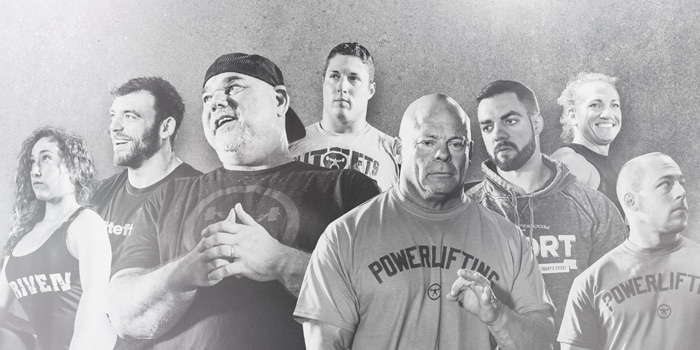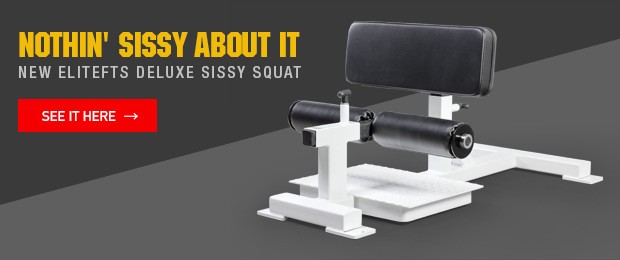
In the world of athletics, there seems to be a new bone of contention between coaches. In question is if hypertrophy has a place in athletics.
At first glance, you'd think that this is a no-brainer. Of course, you want your athletes to get bigger and stronger for their sport, but as you start to dissect the issue further, you find that, like with most situations, “it depends.”
Instead of dropping that “It depends” smoke bomb on the conversation and walking away, we at elitefts decided to get first-hand accounts and experiences from some of our coaches to get their perspective on the issue.
Some of the brightest minds present both sides of the argument in the strength and conditioning field. This is an invaluable tool that you can utilize to spark your own conversations and help build the best program and training plan for your teams, athletes, and clients based on your particular situation.

strelok © 123rf.com
Hypertrophy HAS a Place in Athletics
"Direct hypertrophy work can help correct muscular imbalances and weaknesses that could have an inherent negative effect on the athlete’s performance. (Sport-, individual-, position-, and age-specific)." —Anne Sheehan
"Hypertrophy work can be used as “homework” for athletes to do on their own. This allows the athlete to work on a specific portion of their training outside of the team training, thus increasing the time the team can work on more important training adaptations and skills." —Harry Selkow
"Hypertrophy work for athletes can aid both in injury prevention and building kinesthetic awareness in younger athletes." —Ben Pollack
"Depending on the league, age, and training level, you will find that most athletes are undersized, need strength development, and hypertrophy training." —Casey Williams
"High-level bodybuilding-style hypertrophy training, no. Training that elicits hypertrophic responses in athletes, yes (especially if they are younger and undersized). This is much simpler and time-efficient and will support injury prevention and performance improvements." —Joe Schillero
"Incorporating myofibrillar hypertrophy-based rep ranges rather than sarcoplasmic hypertrophy-based rep ranges for athletes helps to reduce the time you need; can utilize bigger exercise movements, and is generally better for overall function and performance (utilizing triplane movement when possible). However, I would not agree that putting an athlete on a strict hypertrophy phase is a good idea while neglecting other adaptations such as speed, power, and strength." —Brandon Smitley
"Hypertrophy training that elicits an increase in myofiber size has a place in all sports. The presence of muscle mass acts as a shock absorber to surrounding body architecture (bones, joints, etc.). In contact sports like football or wrestling, the presence of muscle mass is critical for injury prevention. The same is true for sports involving repeated jumping, bounding, etc. The presence of muscle mass helps mediate the amount of direct loading damage when one lands sub-optimally/crappily. In my opinion, a base level of some mass is needed before an attempt to train heavily loaded/quickly loaded. It also aids in tendon health. In sports that aren’t bodybuilding things, if we want to look at things simply, the action of doing the sport will keep someone athletic, and the actual presence of muscle mass is going to help keep them healthy. This is speaking in general terms and is not meant to be specific to all situations, athletes, etc.
After years of research studying muscle hypertrophy, I can tell you that acquiring mass isn’t as complicated as we might think. It comes down to a new loading stimulus, recovering from the stimulus, then adapting, which supports the functional change. That means that even if you had kids doing some stuff like on this machine and do 3x10 leg presses, extensions, hammy curls, and then go to practice and proceed to jump and sprint, I doubt the body would be like, “Oh, we did a 3x10 classic bodybuilding workout, we will not adapt by increasing the number of sarcoplasmic proteins and hence the muscle fiber size by increasing the non-myofibrillar components.” I bet it would respond by repairing the muscle damage and adapting so that when the kid went to lift, jump, or sprint, they would be just a bit better if they sufficiently recovered. Now the specificity of the weight training loading for hypertrophy vs. speed vs. strength obviously changes as the athlete’s “gym” age and sports age advance. I for sure believe in this, but in general, I think it’s important to remember that for most, the addition of muscle mass to an athlete that begins “gym training” is beneficial." —Jenn Petrosino
"Hypertrophy/anatomical adaptation is the base of a good training program. If you want to be good at sport X, we can increase specific performance measures in training. Those are increased through a core set of movements (squat, bench, overhead press, clean, whatever). To increase those movements, we train the supplemental movement that benefits the main movements. After that, we look to build those supplemental movements on localized accessory work to build size and mind-muscle control of specific muscle groups (hypertrophy)." —Tyrel Detweiler
"If the athletes are undersized for their sport/position, then there needs to be time for SPECIFICALLY working on hypertrophy and the growth of tissue. This could also be replaced by the anatomical adaptation phase that is never talked about anymore (joints, ligaments, work capacity, etc.).
Here's a point that I want to bring up being in college athletics: The traditional westernized periodization has some major flaws for the current college athlete in most sports, as they have an "off-season" season. When presented with five weeks for the off-season, you have to determine what to develop. If they're big enough for their position, why spend the time there? Here are two common arguments:
For tendon adaptations, many people hit that as a response for hypertrophy work, and it's valid. But what seems to do better? Maximal isometrics, according to work by Kenneth Baar.
To improve the anaerobic capacity, I'd rather do this with running and get the enzymes into the appropriate tissues instead of other areas.
Give me five weeks with a big dude; it's force and velocity. Give me 16 weeks with a big dude; it could be a different story.
As with all things, it's context-dependent. For athletes with the current CBA restrictions in pro sports and the schedules impacting sports such as football, baseball, and basketball, I don't do a hypertrophy phase. I don't feel there is enough time WHEN THE ATHLETE ALREADY HAS ENOUGH SIZE. Momentum (the combination of velocity and mass) is one of the major factors for playing time for football and rugby. If the person is undersized and fast, getting them bigger will most likely help, even if they slow down a bit. Strength to mass ratio matters too." —Bryan Mann

strelok © 123rf.com
Hypertrophy DOES NOT Have a Place in Athletes
"I think defining hypertrophy a bit better would help too. If you were asking about exclusively training hypertrophy, I would say no as the economics of most sports do not allow the necessary time to hit 10 sets of glutes, quads, calves, etc. It also would be too far removed from carrying over to sport to spend that kind of time only training hypertrophy as the primary adaptation." —Tyrel Detweiler
"One of the cons for coaches, not online coaches, but coaches working with teams is the cost in terms of training time and setup. Most are already VERY pressed for time and compliance. In many cases, to fit this in, something else in the training program needs to come out. What gets pulled? How do the priorities stack when also addressing movement mechanics, tactical skills, recovery, power, and so on? When talking about not including hypertrophy work into an athlete’s program, it’s almost always time-related." —Dave Tate
"Hypertrophy should be done on the athlete’s own time to maximize the availability of time and resources available when training in a team environment." —Harry Selkow
"The argument against this is valid because of time constraints. In my opinion, though, the bigger issue there is poor coaching and management skills. It reminds me of an old training partner I had who would constantly be adding new drills and exercises to our training plan. Coaches do the same thing—we need to add these five drills because so and so in the league added them. Meanwhile, nothing is taken out." —Casey Williams
"In its truest sense, hypertrophy training would be at the bottom of my list of modalities to use for athletes. Now, that’s if we are talking about true hypertrophy training where we are focusing on external stability to drive maximal output—really trying to isolate movements to target specific muscle groups. Hypertrophy results from mechanical tension and metabolite build-up, which when taking close to failure, elicit the greatest response. That style of training generates a ton of fatigue, especially in the CNS, based on the literature. I feel like it creates the most fatigue without a ton of carryover. Time could be spent elsewhere. Most athletes need to move better, improve body awareness, train force absorption and deceleration, and get stronger. I don’t think true hypertrophy training lends itself to those things.
Hypertrophy is a byproduct of the training, I still don’t think it should be specifically trained for, and to me, that’s the biggest difference. You can grow muscle in rep ranges of three to thirty, but you can also train different adaptations in those ranges. Tissue tolerance can be built through slow and heavy eccentrics and isometrics. Imbalances can be fixed through proper exercise selection. There are so many things that can create a hypertrophic stimulus that has far better carryover." —Tony Mongomery
"Bryan Mann hit what may be the biggest point with athletes at the high school levels and above. Every sport has its sport-imposed restrictions to training (their practice and game schedules), plus the NCAA restrictions. Everything is easy in theory until you sit down with a coach and start helping them layout their annual training plan. That's when reality hits and priorities get established. These can seem as cons, but in a way, offer many advantages. Tony Montgomery hit on the other big one. I believe the biggest issue is personal bias and needs analysis. More times than not, a coach's personal bias overshadows what would be seen in a needs analysis of an individual athlete or team. The overreaching objective is better athletes and/or teams. Many times this gets lost as the coaches try to put their personal stamp (brand) on the team or athlete." —Dave Tate
Interested in getting Team elitefts coach’s opinions on other topics? Add comments or suggestions you have in the comments section below. Email Sam Brown at sbrown@elitefts.net to have your topic discussed by some of the brightest minds in the world of strength and conditioning and training.










I use finishers at the end of the workouts that last 10-12 min. Example- Leg day/ upper body finisher Upper body day/- lower body finisher. Dave Tate suggested in a seminar I attended at his compound that hypertrophy exercises can be part of a conjugated training design.